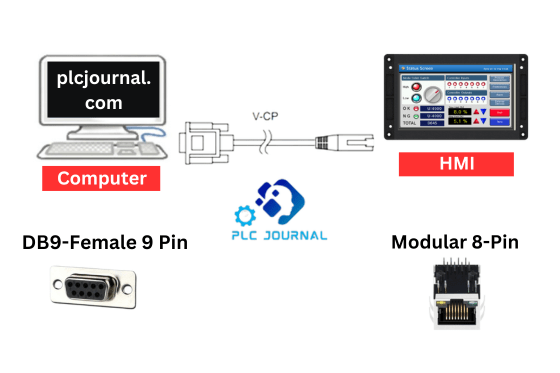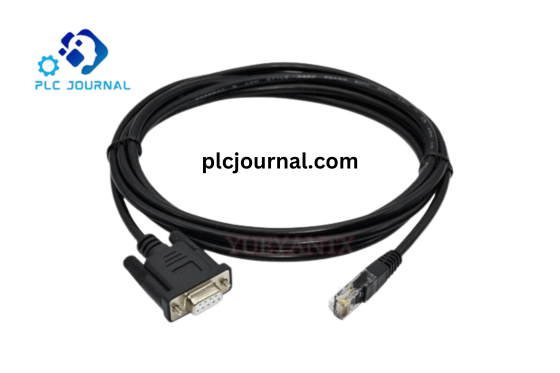Connecting Fuji/Hakko HMI to PC via RS232 Port: A Step-by-Step Guide
In today’s technological era, human-machine interfaces (HMIs) play a pivotal role in industrial automation. Fuji and Hakko, renowned for their quality HMI products, offer a range of devices suitable for various applications. To harness the full potential of these HMIs, connecting them to a PC via an RS232 port can be essential. In this guide, we’ll walk you through the process of making an RS232 cable for Fuji/Hakko HMIs, which can be applied to UG220, UG330, V4, V6, V7, and V8 Series devices.
Why Connect Your HMI to a PC?

Before diving into the technical details, let’s understand the significance of connecting your Fuji/Hakko HMI to a PC. This connection provides several advantages:
- Data Transfer: Connecting your HMI to a PC allows for seamless data transfer. You can upload and download project files, configurations, and data logs, making it easier to monitor and control your automation system.
- Remote Access: With the HMI connected to your PC, you can remotely monitor and control your industrial processes, enhancing efficiency and reducing downtime.
- Real-time Monitoring: Real-time data monitoring becomes possible, enabling you to make informed decisions and troubleshoot issues promptly.
- Programming and Configuration: By connecting to your PC, you can conveniently program and configure your HMI, streamlining the customization process.
Making the RS232 Cable

Now, let’s proceed with creating the RS232 cable to connect your Fuji/Hakko HMI to your PC. Ensure you have the necessary materials:
- DB9 Male Connector
- RJ45 Connector
- RS232 Cable (with DB9 Female Connector on one end)
- Soldering Iron and Solder
- Wire Strippers
- Multimeter (for testing continuity)
Steps to Create the RS232 Cable:
- Prepare the RS232 Cable: If your RS232 cable has a DB9 female connector on one end, cut off the other end. Strip the outer insulation to reveal the inner wires.
- Identify the Wires: Inside the RS232 cable, you’ll typically find wires in different colors. The key wires to identify are Tx (Transmit), Rx (Receive), and GND (Ground). Use a multimeter to determine the corresponding pins on the DB9 female connector.
- Solder the Connections:
- Connect the Tx wire (usually white) to Pin 2 (Transmit) on the DB9 connector.
- Connect the Rx wire (usually black) to Pin 3 (Receive) on the DB9 connector.
- Connect the GND wire (usually green) to Pin 5 (Ground) on the DB9 connector.
- Prepare the RJ45 Connector: Strip the outer insulation of the RJ45 connector’s cable to expose the inner wires. Typically, you will find eight wires, but you’ll only need three.
- Solder the Connections:
- Connect the wire you’ve identified as Tx to Pin 4 (Transmit) on the RJ45 connector.
- Connect the wire you’ve identified as Rx to Pin 5 (Receive) on the RJ45 connector.
- Connect the wire you’ve identified as GND to Pin 3 (Ground) on the RJ45 connector.
- Testing: After soldering the connections, use a multimeter to test the continuity of each connection to ensure there are no short circuits or open circuits.
With the RS232 cable now assembled, you can confidently connect your Fuji/Hakko HMI to your PC. Follow the provided connection diagram for your specific HMI model, and you’ll be ready to unlock the full potential of your industrial automation system.
In conclusion, establishing a connection between your Fuji/Hakko HMI and PC via an RS232 cable is a valuable step in enhancing your industrial automation capabilities. This guide has walked you through the process of creating the cable, and with the right connections in place, you can enjoy improved data transfer, remote access, real-time monitoring, and efficient programming for your HMI devices.
Technical Guides
What Is a Programmable Logic Controller (PLC)? Full Explanation
What is HMI? Human-Machine Interface (HMI)-Full Explanation
What is a Variable Frequency Drive?-It’s complete guidelines
What Is a Servo drive and How Does it Work? It’s complete guidelines
Manual PDF
[PDF] Delta PLC DVP-ES2/EX2/SS2/SA2/SX2/SE&TP Operation Manual Free Download
Delta HMI-DOPSoft User Manual Free Download [PDF]
Cable Making
[DIY-Cable] PLC/HMI-Panasonic Connecting PC
[DIY-Cable] PLC/HMI-Keyence Connecting PC
[DIY-Cable] S7-200 Siemens Connecting PC
[DIY-Cable] Mitsubishi PLC Programming Cable SC-09 for FX-Series
[DIY-Cable] PLC Delta Programming Cable DVPACAB230
[DIY-Cable] PLC OMRON Programing Cable for CJ/CS/CQ-Series
[DIY-Cable] PLC “LS/LG” Programing Cable
[DIY-Cable] PLC “Fatek/Facon” Programing Cable
[DIY-Cable] PLC “Vigor” Programing Cable
[DIY-Cable] HMI “Fuji/Hakko” Programing Cable
[DIY-Cable] “HMI Omron NT-Series” Programing Cable
[DIY-Cable] HMI Keyence “VT3-W4 Series” Cable Connecting To PLC
[PDF] HMI-Weintek Connection PLC Guide
![[DIY-Cable] HMI “FujiHakko” Programing Cable [DIY-Cable] HMI “FujiHakko” Programing Cable](https://plcjournal.com/wp-content/uploads/2023/09/DIY-Cable-HMI-FujiHakko-Programing-Cable.png)


I appreciate the dedication to accuracy and relevance on this site. It’s evident that the team cares about delivering valuable content to its audience. Well done!